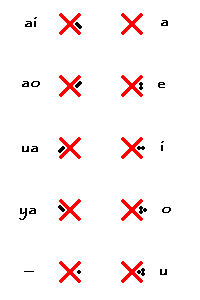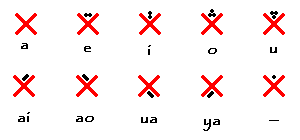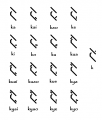Kala writing: Difference between revisions
From FrathWiki
Jump to navigationJump to search
m (→Index) |
m (→Hama Table) |
||
| Line 58: | Line 58: | ||
=== Hama Table === | === Hama Table === | ||
* Number 1 is the base word '''hama''' in the '''kalai''' mode. | |||
* In #2, '''huemyao''', the labialization mark can be seen below the '''ha''', and the '''e''' diacritic can be seen above. The palatalization mark can be seen below the '''ma''', but the '''ao''' diacritic can be seen above the '''pekoli'''. | |||
* Whenever a word ends in a vowel the '''pekoli''' (tail-mark) is present and will 'carry' the final vowel. | |||
*In #3, the labialization and palatalization marks are the only used. | |||
*Number 4 is plainly divergent from the previous three. It makes use of the '''pemato''' (reverse-mark) to indicate that the base is '''aham''' and not '''hama'''. This mark can be used on any syllable at any place in the word with exception of the '''pekoli'''. | |||
*Example #7 shows the '''pe’uku''' (stop-mark) above the '''ma''' syllable, which indicates that the syllable lacks a vowel; in this case the '''pekoli''' is left off as well. | |||
=== Panaha Table === | === Panaha Table === | ||
Revision as of 18:43, 4 December 2009
Moya
Moya is an abugida, or abjad used to represent the Kala language.
Notable features
- Moya is written vertically, in columns running from left to right, when necessary, or for aesthetic reasons it can be written horizontally.
- The word moya not only refers to the script but also means "to write, character, letter" in Kala.
- Moya contains 14 consonant syllables, two vowel markers and ten vowel diacritics.
Moya Consonants, or Syllables
- Looking closely, you will notice that the symbols are arranged by phonetic relation, making Moya semi-featural.
Vowels (Diacritics)
- The vowels vary in direction between the two modes, vertical (ukaha) and horizontal (kalai).
- The ukaha mode vowels are turned 90° from their position in the kalai mode.
Ukaha vowels
Kalai vowels
Notes
- Full vowel indication (vocalization) can be added, by means of vowel diacritics, but this is only done to eliminate confusion.
- The script can also be written horizontally, but this is only done to save space.
- There is very little punctuation used in Kala, pauses, stops and questions are understood through the use of context and particles.
- Most often the vowels are not marked, the single diagonal mark is used to show that a vowel begins or ends the word, and is also used to connect graphemes that otherwise would not connect based on the normal methods of connecting.
Tables & Charts
Ka Table
- The ka syllable with all possible vowel combinations and permutations.
- Whenever a word ends in a vowel the pekoli (tail-mark) is present and will 'carry' the final vowel.
- If the consonant is labialized or palatalized those pehim (little marks) will be marked on the consonant.
- Note the kyao & kuai syllables.
Hama Table
- Number 1 is the base word hama in the kalai mode.
- In #2, huemyao, the labialization mark can be seen below the ha, and the e diacritic can be seen above. The palatalization mark can be seen below the ma, but the ao diacritic can be seen above the pekoli.
- Whenever a word ends in a vowel the pekoli (tail-mark) is present and will 'carry' the final vowel.
- In #3, the labialization and palatalization marks are the only used.
- Number 4 is plainly divergent from the previous three. It makes use of the pemato (reverse-mark) to indicate that the base is aham and not hama. This mark can be used on any syllable at any place in the word with exception of the pekoli.
- Example #7 shows the pe’uku (stop-mark) above the ma syllable, which indicates that the syllable lacks a vowel; in this case the pekoli is left off as well.





